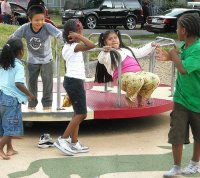Playground Neuroscience: Connect and Redirect
"She makes my life miserable every day!" cries Madison, one of the girls in my fourth grade class. She sinks her chubby frame onto the bench next to me, and folds her arms dramatically over her uniform. A pout curls her lower lip and tears twinkle inside her eyelids as she dashes a fierce glance sideways at Hailey, who is still blissfully hanging upside down on the monkey bars.
As the adult, and her teacher, of course I have to respond and help Madison deal with this playground problem. Several options start taking shape in my mind. I can:
- Put my arm around her shoulders and sigh, "I know. Friendships can be really hard!"
- Help her develop a strategy for mending her friendship.
What’s the best tack to take? Is there a "right" way to deal with this playground drama in the ten minutes we have left in recess?
Logic or Emotion?
Most teachers, myself included, are well trained in teaching academic skills and strategies for tackling intellectual problems. We can teach our students how to summarize a passage, add fractions, investigate a scientific inquiry. However, in cases like Madison's, we aren't faced with an academic problem. When it comes to these situations, we are often untrained in supporting the emotional development of children.
I was happy to find a very simple scientific explanation of and satisfying answer to the question of how to deal with such playground dramas. According to neuroscientist Daniel Siegel, M.D., there is and easy and precise strategy that we -- teachers, parents, adults -- should use in these emotional cases. By proceeding according to these scientific findings, we will guide a student to navigate this emotional issue, help wire her brain to be prepared for dealing with similar future scenarios, and improve our connection with the child. In his book The Whole-Brain Child, Dr. Siegel calls the strategy "connect and redirect."
In order to understand this strategy, let's start with a basic review of brain structure and function. Our brain has two hemispheres, the left and the right, which are connected through a pathway of nerves. Although no task, action or thinking process is conducted only in one hemisphere, each hemisphere has an expertise, or a type of processing which it dominates. Allow me to oversimplify. The left hemisphere tends to dominate linear, literal and logical thinking. It likes to solve puzzles, especially using order and reason, and serves us in linguistic expression. The right hemisphere is often thought of as the more creative side of our brain. It dominates non-verbal communication, emotions and creative expression through activities such as art or dance.
So what does this have to do with Madison's and my dilemma?
Empathy First
What happened to Madison is that her brain's right hemisphere (the emotional one) has taken over control and is not communicating with her left (more logical) hemisphere. She is flooded with emotions, which leaves little space for the logical reasoning of her left brain. Although it may be tempting for adults to respond to an emotional child in a way that brings logic and reason to the blustery situation, this approach will most likely lead to frustration for the child and the adult. When Madison is flooded with emotions about the incident with Hailey, it will not do any good to proceed with choice number two, which is analyzing the problem. Analysis and strategic thinking are activities dominated by the left brain, to which Madison currently does not have access.
According to the "connect and redirect" strategy, I must first use my right brain (empathy) to connect with hers. I should proceed with choice number one: acknowledge and empathize with Madison’s feelings, using words such as, "Boy, friendship sure can be hard. I know how bad it feels when my friends make me cry!" Such display of empathy will allow Madison to "feel felt" and relax a little. Once she has calmed down, the left hemisphere is more available to participate in this crisis. When I see that Madison is no longer overwhelmed by emotions, I might try the other tack. In this situation, it might not be possible until several hours later, or perhaps the next day. Only when the emotional flooding has subsided and the child has calmed down, can I redirect her by helping her analyze what went wrong in the incident with her friend and guide her to find a strategy for mending the friendship. By connecting with the right brain and redirecting with the left, I integrate both sides of Madison's brain, training the neuropathways to do this independently somewhere down the road.
We have all experienced this kind of situation before, whether we've seen it in ourselves or in others. In fact, adults also get flooded with the emotions of our right brain. You might remember when you felt upset, and your spouse tried to make you feel better by way of a logical explanation. Did it work? Probably not. This is not news under the sun! But there is something powerful about understanding the science of why this works. When we have such understanding, we are more likely to use it.
